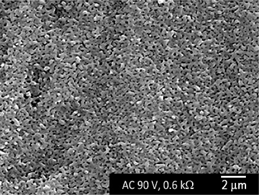No CrossRef data available.
Article contents
Preparation of nanosized porous oxide layers on titanium by asymmetric AC electrolysis in sulfuric acid
Published online by Cambridge University Press: 29 January 2019
Abstract

The formation of nanosized porous oxide layers on titanium (Ti) by asymmetric alternating current anodizing in sulfuric acid has been studied using electrochemical techniques. In order to prevent spark discharge at Ti electrode upon its anodization in 1.0 M H2SO4 solution, the magnitude of the cathodic current is reduced using a special electrical circuit consisting of a variable resistor and two diodes. The unique surface treatment approach gives rise to the formation of nanosized porous layer in a very short period of time and without spark discharge. The surface of porous layers thus obtained has in vitro apatite-forming ability.
- Type
- Research Letters
- Information
- Copyright
- Copyright © Materials Research Society 2019




